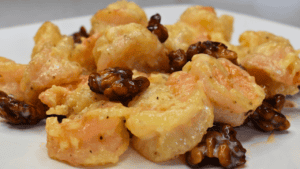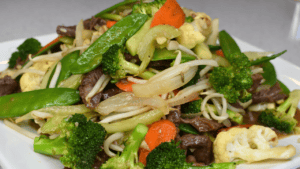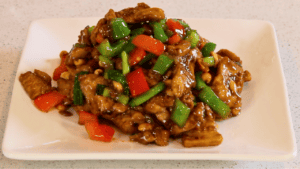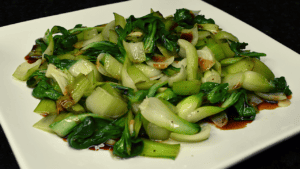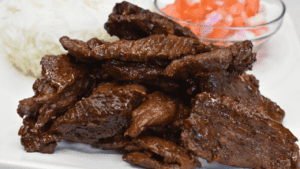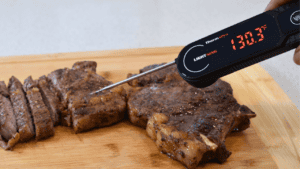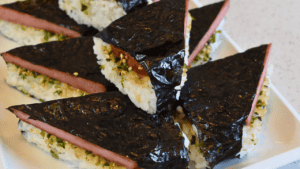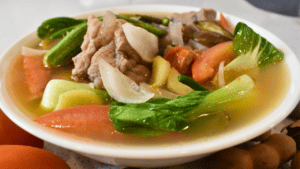Spam Musubi
Spam musubi is a popular Hawaiian dish that has gained widespread popularity outside of Hawaii. It consists of grilled or fried spam, a canned meat product, served on top of sushi rice and wrapped in seaweed.
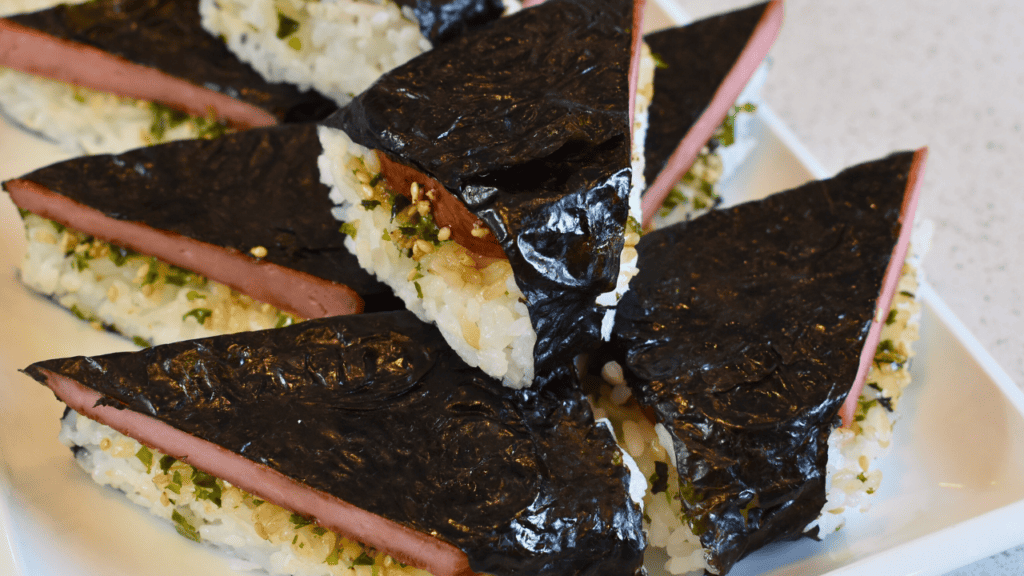
Spam Musubi is frequently found in convenience stores and at beachside barbecues. It is well worth learning how to make it yourself.
First and foremost, the rice is the foundation for the musubi. The proper type of rice to use is short-grain sushi rice which is cooked until it is sticky.
Next comes the star of the dish, the Spam. This canned meat is sliced and fried in a pan until it becomes crispy and golden brown on both sides. The longer it cooks, the crispier it gets, adding a savory texture that complements the moist rice.
The two components are then assembled by placing a slice of Spam on top of a bed of rice before wrapping everything together using a sheet of roasted seaweed. The combination of salty Spam, sweet rice, and umami-rich seaweed creates a well-balanced and enticing snack.
Furikake, a Japanese seasoning blend made up of assorted ingredients such as nori, bonito, sesame seeds, and dried shrimp. It is sprinkled on top to add another layer of flavor and texture.
Making Spam Musubi is simple and the result is a delightful snack that can be eaten anytime and anywhere.
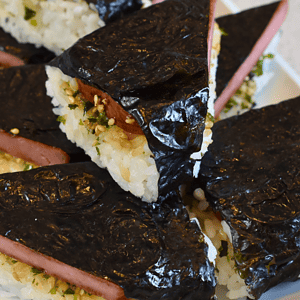
Spam Musubi
Ingredients
- 1 can spam
- 2 cups rice cooked
- 3 sheets nori roasted seaweed sheets
- 2 tbsp rice vinegar
- 2 tbsp soy sauce
- 1 tbsp sesame oil
- ¼ tsp cornstarch
- ¼ cup brown sugar
- furikake Japanese seasoning
Instructions
- Start by cooking two cups of sushi rice.
- Prepare the sauce by combining brown sugar, soy sauce, rice vinegar, sesame oil, and cornstarch in a small mixing bowl. Mix well and set aside.
- Open a can of Spam and cut it into seven equal slices.
- Heat a non-stick skillet or pan over medium-high heat and brush it with cooking oil.
- Fry the sliced Spam until golden brown on both sides, which should take approximately 4 minutes per side.
- Assemble the musubis and sprinkle them with furikake seasoning to add flavor.
- Finally, slice the musubis into bite-sized pieces for serving.
Video
Nutrition
What is spam musubi sauce made of?
Spam musubi sauce, also known as “teriyaki sauce,” is a popular condiment in Hawaiian cuisine. It is typically used to add a sweet and savory flavor to the iconic spam musubi dish.
The traditional recipe for spam musubi sauce includes soy sauce, sugar, mirin (sweet rice wine), and sake (Japanese rice wine). However, depending on personal preferences. Some people may also add ingredients such as garlic, ginger, pineapple juice, or even honey to enhance the flavor profile.
The key ingredient
The key ingredient of this beloved sauce is without a doubt soy sauce. This dark and salty liquid is made from fermented soybeans mixed with roasted grains like wheat or barley. Its umami-rich taste perfectly balances the sweetness of the other ingredients in spam musubi sauce.
Next up is sugar – usually white or brown sugar – which acts as a natural sweetener in this recipe. The amount of sugar used can vary according to individual tastes.
Mirin brings another level of sweetness to the mix with its slightly thicker consistency compared to sake. It also adds depth to the overall taste profile of the dish.
Last but not least is sake – often referred to as “rice wine” due to its production process using fermented rice. As mentioned earlier, some variations call for pineapple juice or honey instead of sake for their unique sweetness.
To make your own spam musubi sauce at home, simply combine equal parts soy sauce and mirin with half part sugar (e.g., 1 cup each soy sauce & mirin + ½ cup sugar) along with any additional desired ingredients like garlic or ginger in a small pot over medium heat. Stir until all ingredients are well combined and bring it to a simmer. Let it cool before using as a marinade or dipping sauce.
How do you make musubi not fall apart?
One common issue many people face when making musubi is keeping it from falling apart. As someone who has had their fair share of musubi disasters and successes, let me share some tips and tricks to help you achieve the perfect musubi without it unraveling.
1) Start with the Right Rice. The key to a successful musubi lies in its rice. It should be short-grain Japanese white rice as it has the necessary starch content to hold everything together. Other types of rice may not have enough stickiness and can result in a crumbly mess.
2) Cook Your Rice Correctly. Making sure your rice is cooked properly also plays an important role in preventing your musubi from falling apart. Use the precise ratio of water to rice suggested on the packaging and follow cooking instructions carefully. Overcooked or undercooked rice will not produce the desired texture for musubi.
3) Use Sushi Vinegar. Once your rice is cooked and cooled slightly, gently mix in some sushi vinegar before molding it into shape. This will add flavor to your musubi while helping the grains stick together better.
4) Wet Your Hands Before Handling Rice. When shaping your musubi by hand, dip your hands in water before handling the sticky rice. This prevents it from sticking too much to your hands and helps evenly distribute moisture throughout each grain for optimal binding.
5) Press Firmly but Gently. When pressing down on your shaped musubi with a mold or using just your hands, make sure to apply enough pressure for everything to stick together without squishing or breaking any ingredients inside.
6) Wrap Properly. Lastly, ensure you wrap up each finished piece tightly using nori (seaweed) or plastic wrap. This holds everything in place and also adds an extra layer of protection.
How far ahead can you make musubi?
To answer the question at hand, there is no definite limit to how far ahead you can make musubi. The shelf life of this portable snack mainly depends on the type and freshness of ingredients used. However, if prepared correctly and stored properly, musubi can last for up to three days without losing its flavor or texture.
The key to making long-lasting musubi is using fresh ingredients and proper storage techniques. Let’s start with the base ingredient – rice. It is essential to use high-quality short-grain sushi rice when making musubi as it has a stickier texture than other types of rice. The stickiness helps hold all the other ingredients together while also enhancing its overall taste.
When it comes to fillings, there are no rules set in stone. However, some traditional options include spam (a canned meat product), cooked teriyaki chicken or beef, sliced eggs or tamagoyaki (Japanese rolled omelet), pickled vegetables such as carrots or cucumbers, avocado slices and even hot dogs! You can get creative with your fillings by adding your favorite sauces such as sriracha mayo or eel sauce for an extra kick of flavor.
Once you have assembled your desired filling combination on top of a layer of seasoned sushi rice (don’t forget to sprinkle some furikake seasoning for added flavor!), wrap it tightly in nori seaweed sheets using plastic wrap or a bamboo mat. This will ensure that moisture does not seep into the rice causing it to spoil quickly.
Now onto storage – refrigeration is key to keeping your musubi fresh for an extended period. Once assembled, wrap each individual musubi in plastic wrap and store them in an airtight container or ziplock bag. This will prevent the rice from drying out and ensure that the fillings stay fresh.
Are spam musubis unhealthy?
While they may be considered unhealthy by some due to the high sodium content of spam and the use of white rice, there are many factors to consider when determining if something is truly unhealthy.
First and foremost, let’s take a closer look at the ingredients used in making spam musubis. Spam itself is made from pork shoulder meat that is chopped and mixed with salt, water, sugar, potato starch, and sodium nitrite (a preservative). While it does contain a high amount of sodium per serving (around 790mg), it also provides protein and iron which our bodies need for various functions such as building muscles and carrying oxygen in our blood.
As for the white rice used in this dish, yes it does have higher amounts of carbs compared to brown or whole grain rice. However, it also contains essential nutrients such as magnesium which plays a role in maintaining healthy bones and regulating blood pressure.
Factor to consider
When evaluating the healthiness of any food is portion size. A typical serving size for one spam musubi is around 4oz or 113g which equates to about one-third cup cooked white rice. Consuming one or two servings occasionally will not significantly impact your overall health as long as you maintain a balanced diet consisting mostly of whole foods like fruits, vegetables, lean proteins, and complex carbohydrates.
Moreover, moderation is key when it comes to any type of food consumption. Eating spam musubis every day may not be wise due to its high sodium content but enjoying them once in a while should not be cause for concern.
Additionally, there are ways to make healthier versions of this beloved snack by swapping out ingredients without sacrificing flavor. For example, using brown rice instead of white rice and opting for reduced-sodium spam can significantly lower the sodium content without compromising taste.
Lastly, it’s essential to remember that food is not just about its nutritional value. But also about cultural significance and enjoyment. Spam musubis have been a staple in Hawaiian cuisine for decades and hold sentimental value for many people. It brings communities together at events such as picnics, potlucks, and family gatherings. The social aspect of food cannot be overlooked when discussing its impact on our overall well-being.
In conclusion, while spam musubis may not be the healthiest snack option out there. They can still be enjoyed in moderation as part of a diverse and balanced diet. And with some simple tweaks to ingredients or portion size, they can even become a healthier choice without losing their deliciousness. So next time you’re craving this tasty Hawaiian treat, go ahead and indulge guilt-free!
